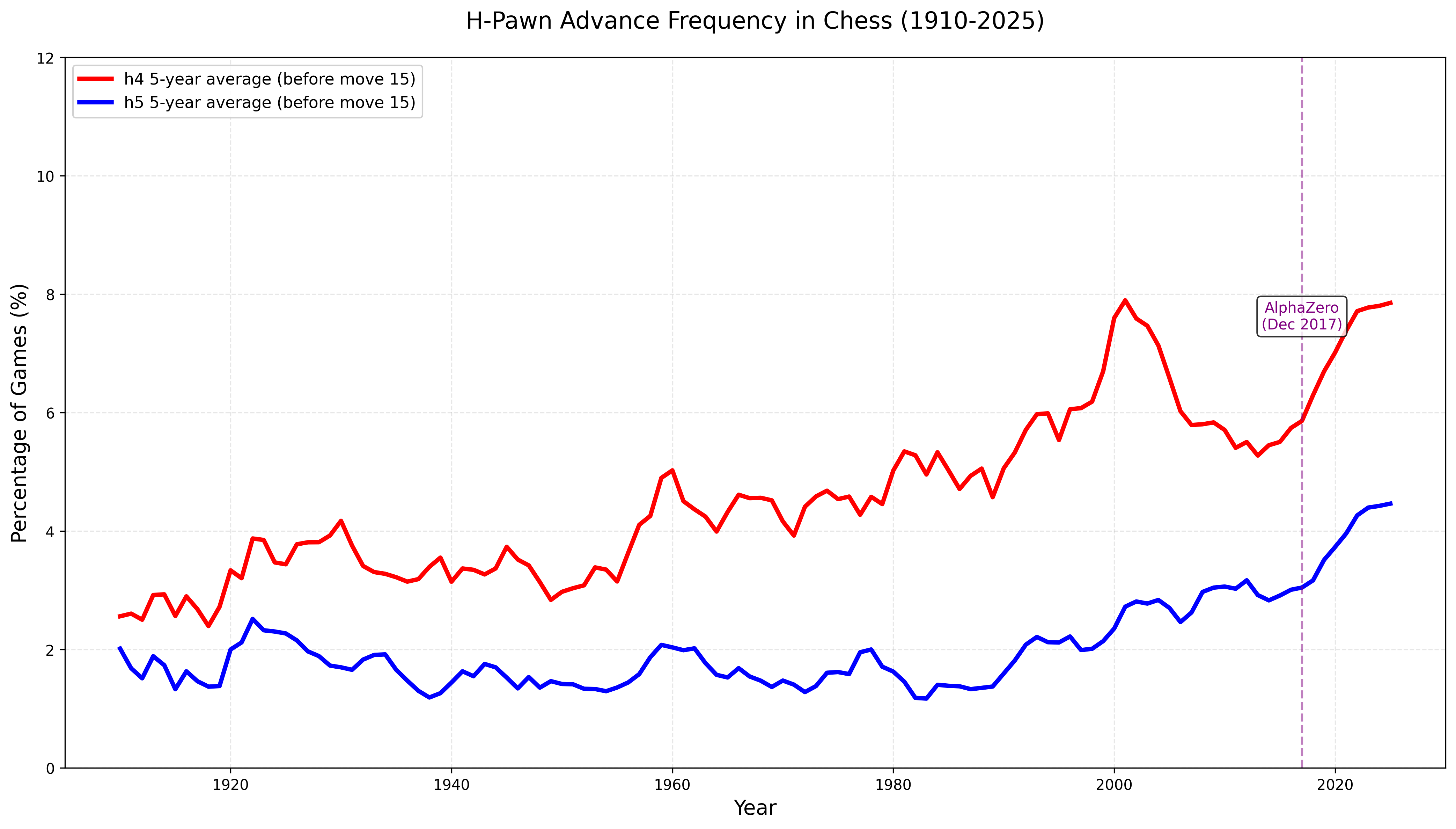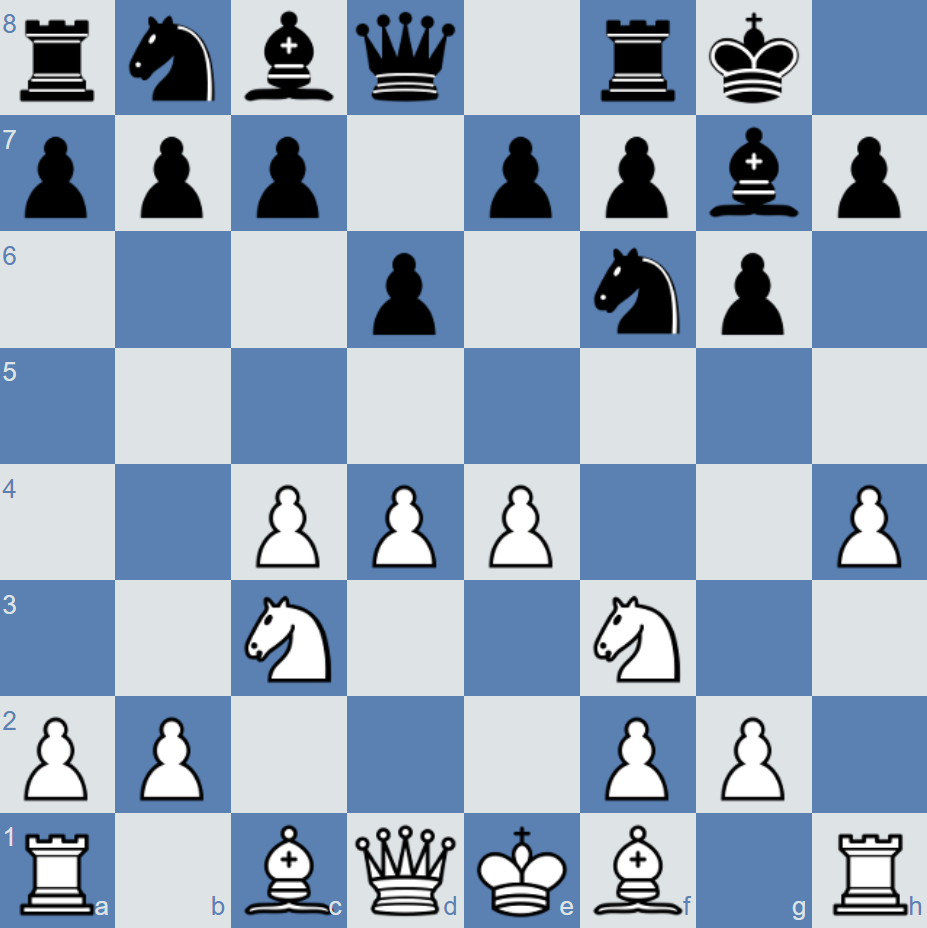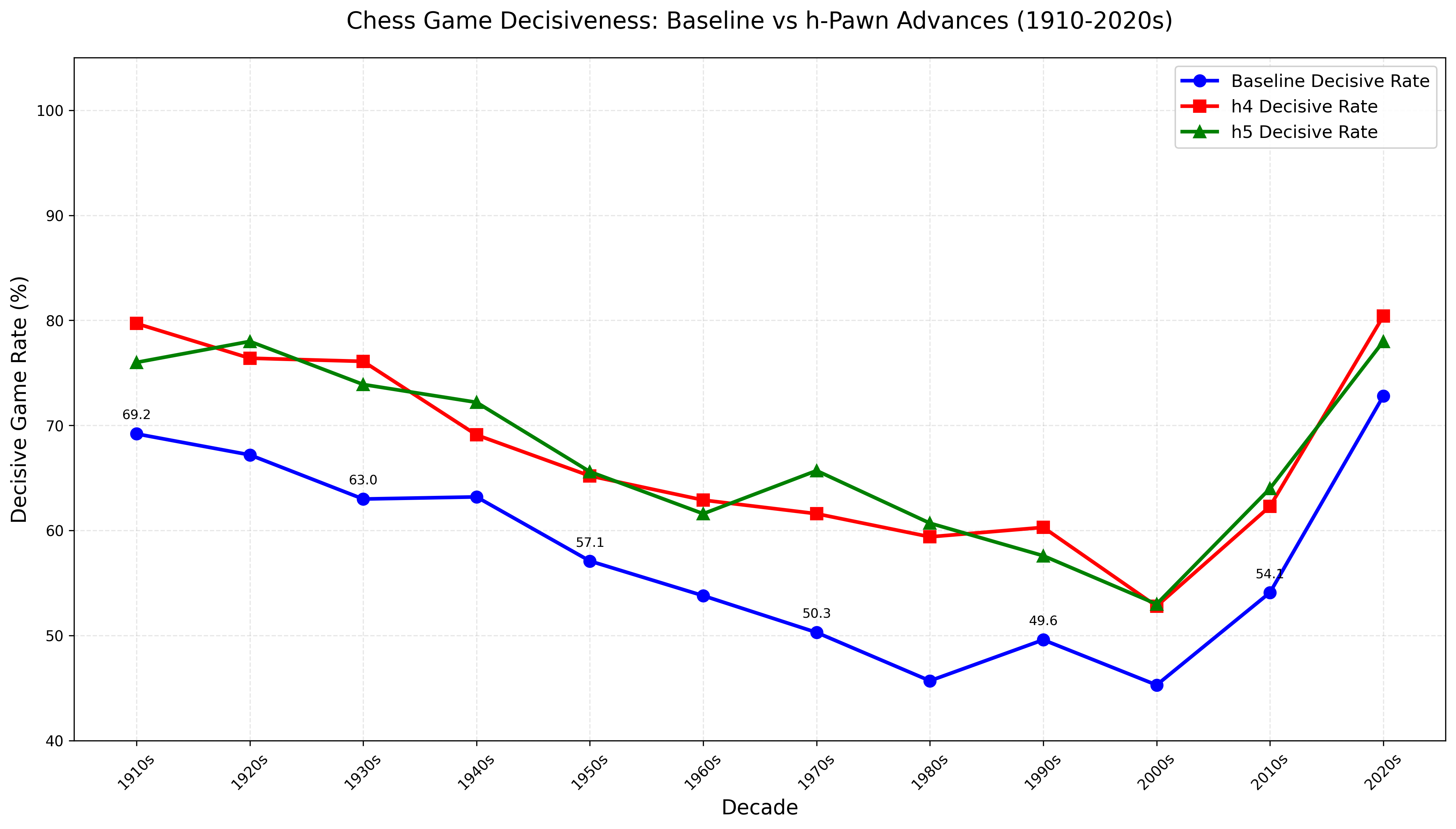The H-Pawn Revolution: How AlphaZero Changed Chess Forever
The Professional Draw "Crisis"
In the 1980s and 1990s, professional chess faced an existential fear. Draw rates at the top level were climbing toward 50-60%, and critics worried that chess was becoming "played out," with all the best lines more often than not leading to draws. Even world champions expressed concern: Emanuel Lasker, José Raúl Capablanca, Bobby Fischer, and Vladimir Kramnik all advocated changing the rules of chess to minimize the number of drawn games.
The rise of powerful chess engines in the 1990s seemed to confirm these fears. If computers could calculate millions of positions per second and still draw most of their games against each other, what hope was there for exciting, decisive chess?
But then something unexpected happened: the very computers that were supposed to make chess boring instead revolutionized it. One of the most surprising changes involved a humble pawn advance that classical chess had long dismissed as anti-positional, or at the very least, highly risky: pushing the h-pawn two squares early in the game.
Early Rebels: The H-Pawn Pioneers
Before the computer revolution validated aggressive h-pawn play, a few players were already experimenting with this unconventional approach. English GM Simon Williams became famous for popularizing "Harry the h-pawn" through his entertaining videos and games. Williams made the move accessible to club players, showing that pushing h4 or h5 could create attacking chances even when it seemed to violate classical principles.
In the late 1990s and early 2000s, a group of aggressive grandmasters began pushing the boundaries of acceptable play. Alexei Shirov, Alexander Morozevich, Michael Adams, and Judit Polgár all contributed to a more dynamic understanding of chess, often employing early pawn advances that previous generations would have questioned.
This explains the curious spike in h-pawn usage around 2000-2005 visible in our data. These attacking players were experimenting with aggressive ideas, pushing h-pawns in positions where classical chess wisdom said to develop pieces first. But without the validation of powerful engines, these experiments were still considered eccentric exceptions rather than sound strategy. When their results proved mixed, the chess world largely returned to more traditional play—until AlphaZero changed everything.
The Data Story: H-Pawn Advances Through History

H-Pawn Advance Frequency in Chess (1910-2025)
Our analysis of over 165,000 games from 1910 to 2025 reveals a fascinating pattern. In the early 20th century, h4 appeared in about 4-5% of games before move 15, while h5 appeared in roughly 2-3%. These percentages remained relatively stable for decades, with some fluctuation but no clear trend.
Classical chess principles explained why: advancing the h-pawn early was considered anti-positional because it:
- Weakened the king's position if castled kingside
- Wasted time that could be spent developing pieces
- Created weaknesses that opponents could exploit
- Violated the principle of controlling the center first
The data bore this out. Throughout most of chess history, playing h4 or h5 early often led to worse results. This created a selection bias: the moves were only played when they were obviously correct, keeping the frequency low but the success rate reasonable. One example of this would have been in the Yugoslav Attack line of the Sicilian Defense, where White castles queenside, thrusts the g and h-pawns up the board, and in the words of Bobby Fischer: "Sac, sac, and mate."
The AlphaZero Earthquake (December 2017)
In December 2017, DeepMind's AlphaZero sent shockwaves through the chess world. The AI system had taught itself chess from scratch in just four hours, then proceeded to crush Stockfish, the world's strongest traditional engine, in a 100-game match.
But it wasn't just that AlphaZero won; it was how it won. The AI played with a style that seemed almost alien to human grandmasters. One of its signature moves was advancing the h-pawn in positions where few humans would consider it. As one analysis noted: "Pushing flank pawns in front of one's king all the way up the board is an idea that had never been taken seriously by grandmasters."
AlphaZero would routinely play h4 as early as move 5 or 6, sometimes even before completing development. In closed positions where humans focused on maneuvering in the center, AlphaZero would launch flank attacks with h4-h5-h6, creating threats that Stockfish, with all its computational firepower, struggled to handle.
The chess world's reaction evolved from confusion to fascination to emulation. If an AI that had learned chess from first principles was playing this way, perhaps human understanding of chess had been too constrained by dogma.
A Signature AlphaZero Game

This position, from one of AlphaZero's games against Stockfish in December 2017, perfectly illustrates the AI's revolutionary approach. In the King's Indian Defense, an opening known for complex middlegame battles, AlphaZero played 6.h4!, advancing the h-pawn before completing development, before castling, even before moving its light-squared bishop.
To traditional chess thinking, this seems premature. White is departing from established principles: develop knights before bishops, castle early for king safety, control the center before attacking on the flanks. Yet AlphaZero's plan proves to be logical. After 6...Nc6 7.Be2 e5 8.d5 Ne7 9.Nh2! Nd7 10.h5!, the h-pawn continues its march. By move 16, AlphaZero had played h6!, permanently cramping Black's kingside.
The game concluded with a brilliant attacking display, as AlphaZero sacrificed material to keep Stockfish's pieces uncoordinated while its passed pawns and active pieces dominated. The final position saw checkmate delivered on move 42—a crushing defeat for the world's strongest traditional engine.
What made this game so influential wasn't just that AlphaZero won, but how it won. The early h4 advance created lasting strategic advantages that Stockfish, despite calculating 70 million positions per second, couldn't properly evaluate or counter. This game, along with others from the match, sent a clear message: human chess understanding had been too narrow, too constrained by rules that were actually just guidelines.
The Data Revolution (2017-2025)
The impact of AlphaZero on human play is clearly visible in our data. After remaining relatively stable for over a century, h-pawn advance frequency suddenly spiked:
- White h4 (before move 15): Rose from 5.5% in the 2010s to 8.0% in the 2020s—a 45% increase
- Black h5 (before move 15): Rose from 3.1% in the 2010s to 4.5% in the 2020s—a 45% increase
But frequency is only part of the story. More importantly, the effectiveness of these moves has withstood tests of the modern era:
Score Impact of H-Pawn Advances by Era
| Era | White h4 Score Impact | Black h5 Score Impact | Sample Size (h4/h5) |
|---|---|---|---|
| 1900s-1920s | +2.6% | +4.5% | 507 / 302 |
| 1930s-1950s | +0.9% | +2.5% | 597 / 311 |
| 1960s-1980s | +1.7% | +0.0% | 1,388 / 584 |
| 1990s-2010s | +2.9% | +0.3% | 3,728 / 1,990 |
| 2020s | +2.0% | +0.7% | 3,415 / 2,024 |
The data reveals that White's h4 has been consistently effective in the computer era, while Black's h5 shows more mixed results. This aligns with the general principle that White's first-move advantage allows for more aggressive play, whereas aggressive h5 thrusts by Black can be double-edged.
Why H-Pawns Create Fighting Chess

Chess Game Decisiveness: Baseline vs h-Pawn Advances (1910-2020s)
One of the most consistent findings in our data is that h-pawn advances create more decisive games. This isn't a recent phenomenon as throughout chess history, games with early h4 or h5 have produced 8-15% fewer draws than average.
Why do these advances lead to more decisive games?
- Space advantage without piece commitment: Unlike developing a piece that can be exchanged, a pawn advance permanently changes the position
- Psychological pressure: Opponents must constantly calculate whether the advancing pawn represents a real threat
- Imbalanced positions: H-pawn advances create the types of asymmetric positions where one side can play for a win
- Time pressure: The concrete nature of flank attacks forces defenders to find precise moves
As our data shows, this effect has been remarkably consistent across eras. In the 1920s, h4 games were 9.2% more decisive than average. In the 2020s, they're 8.0% more decisive. The "h-pawn effect" transcends changes in chess style and understanding.
The practical implication is clear: if you're in a must-win situation, whether in the last round of a tournament or needing to bounce back after a loss, pushing the h-pawn might be exactly what you need. The data suggests it's one of the most effective ways to avoid a draw and create the complex, imbalanced positions where victory is possible.
The Modern Understanding
The 2020s have witnessed a fundamental shift in chess understanding. Far from approaching stagnation, chess has entered a renaissance of aggressive, dynamic play. Our data (representing only classical games) shows that baseline draw rates have plummeted from 54.7% in the 2000s to just 27.2% in the 2020s.
H-pawn advances are just one part of this broader trend toward more aggressive chess. Modern players, informed by engine analysis, understand that many positions previously thought to be too risky are actually playable. The key insight from AlphaZero wasn't just about h-pawns, it was that human chess understanding had been unnecessarily constrained by classical principles that engines like AlphaZero proved to be guidelines rather than rules.
Today's top players have internalized these lessons. Magnus Carlsen, Fabiano Caruana, and others routinely employ early h-pawn advances in positions where previous generations would never have considered them. What was once the trademark of novelty play, or mavericks like Simon Williams, has become standard practice at the highest levels.
Looking Forward
The h-pawn revolution raises a profound question: what other "anti-positional" ideas might actually be correct? If a move dismissed by over a century of chess wisdom can be rehabilitated by AI analysis, what else might we be missing?
Already, we see other classical principles being questioned. Early g4 advances, once considered primitive, now appear in grandmaster games. Piece development, while still important, is sometimes delayed in favor of creating concrete threats. The rigid rules that once defined good chess are giving way to a more flexible, concrete approach.
The democratization of chess knowledge through engines means that these insights aren't limited to elite players. Today, any player with a computer can discover that in a specific position, h4 might be the best move, even if it looks dubious to human eyes.
Fortunately for all of us, chess isn't dying or becoming drawish. Instead, it's evolving into something richer and more complex than previous generations imagined. The h-pawn revolution is just one chapter in this story, but it's a powerful reminder that even after centuries of study, chess still has secrets to be revealed.
The data tells us that chess has evolved from where it was just decades ago: we're seeing both more tactical play and better positional understanding, more decisive games and higher-quality play. The computers that were supposed to solve chess have instead shown us that there was a latent richness waiting to be uncovered.
Harry the h-pawn, once an eccentric visitor, has become a staple of chess at all levels. And chess is more exciting for it.
Methodology: This analysis examined 165,000+ classical chess games from 1910-2025, tracking the frequency and success rates of h4 and h5 advances before move 15.